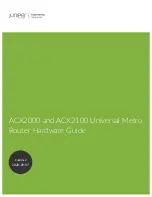
Practical Limitations
Mass Loading
The accelerometer mass should be less than 10% of the rigidly-coupled mass of the test object. The test
object should be rigid at the mounting point, such as a bearing housing rather than a sheet metal cover.
Upper Frequency Response
Piezoelectric accelerometers will attenuate below the low-frequency 3-dB point, but they will amplify at or
near their resonant frequency. The mounted resonant frequency of the accelerometer should be about five
times the highest frequency of interest (for ±0.5 dB accuracy). Refer to the frequency response data
supplied with each accelerometer to establish the usable range. For general surveys or broader tolerances,
smaller multiples may be used. For example, for frequencies up to 1/2 the mounted resonance, sensitivity
would typically be 12% higher than nominal.
Cable-Connector Handling Precautions
Connectors
Clean the connector ends periodically with a stiff-bristle brush (such as a glue brush or small paintbrush
with clipped bristles) dipped in a solvent. This will remove metal slivers (which can peel off connector
threads and short across contacts), oil and other contaminants.
When connecting 10-32 or 5-44, thread the cables to sensor jacks. Do not use pliers to torque knurled
coupling nuts in place. Hand tightening is sufficient for most applications. If the nut tends to loosen under
severe shock or vibration, you may use a mild thread-locking compound. Use it very sparingly and apply
only to the male thread to avoid contamination of the electrical contact.
Because of their size, 10-32 (and smaller) connectors are relatively fragile. Always hold the transducer
steady and twist off the knurled coupling-nut.
Never hold the coupling-nut and twist the transducer.
Use
10-32 (and smaller) connectors only when necessary.
Cables
The weakest point on the cable assembly is at the intersection of the wire and connector; so, avoid stress at
this point. Sharp bends can overstress the conductors and insulation causing shorting or breakage.
The figure shows the preferred methods of cable
routing to the connector. The flexure occurs away
from the intersection point. Relative cable motion
at the sensor body or connector can cause erroneous
output signals at frequencies where cable motion is
amplified (cable “whip”). Miniature accelerometers
are especially susceptible due to their small size and
low mass. This problem is remedied by proper tie
down as shown. A “strain relief loop” will ensure
that cable flexure does not occur at the connector
when the cable is fastened to a stationary surface.
Accelerometer Connections
Triboelectric Noise
Triboelectric noise is caused by the potential developed in a flexing cable. The cable shield may rub
against the cable’s insulator, and the interior friction generates a charge that produces noise. The
triboelectric noise voltage or charge is coupled to the signal leads by inner conductor capacitance and may
be represented by a voltage source in series with a capacitance. In general, triboelectric noise is associated
with bending of signal cables when low-frequency vibrations (below 10Hz) are being measured. If moving
or securing the cable alters the output compared to an external reference, triboelectric noise is a likely
suspect.
DBK Option Cards and Modules
958293
DBK4, pg. 15
Summary of Contents for OMB-DBK-34A
Page 6: ...ii...
Page 10: ...viii 917594 DBK Option Cards Modules User s Manual This page is intentionally blank...
Page 32: ...pg 22 DBK Basics 967794 Daq Systems...
Page 60: ...2 10 System Connections Pinouts 877095 DBK Option Cards and Modules...
Page 84: ...5 8 Troubleshooting Tips 967094 DBK Option Cards and Modules...
Page 94: ...DBK200 Series Boards DBK200 DBK201 DD 10 949794 Dimensional Drawings...
Page 96: ...DBK205 DBK205 DD 12 949794 Dimensional Drawings...
Page 97: ...DBK206 Dimensional Drawings 949794 DD 13...
Page 99: ...DBK208 Dimensional Drawings 949794 DD 15...
Page 100: ...DBK209 DD 16 949794 Dimensional Drawings...
Page 101: ...Dimensions for Miscellaneous Components DIN 1 Dimensional Drawings 949794 DD 17...
Page 102: ...DIN 2 DD 18 949794 Dimensional Drawings...
Page 105: ...DBK Cards Modules Part 1 of 2...
Page 106: ...DBK Cards Modules...
Page 108: ...DBK Cards Modules...
Page 148: ...DBK7 pg 14 879895 DBK Option Cards and Modules...
Page 168: ...DBK15 pg 6 889094 DBK Option Cards and Modules...
Page 182: ...DBK16 pg 14 879895 DBK Option Cards and Modules...
Page 200: ...DBK16 pg 32 879895 DBK Option Cards and Modules...
Page 206: ...DBK17 pg 6 879895 DBK Option Cards and Modules...
Page 218: ...DBK20 and DBK21 pg 6 879795 DBK Option Cards and Modules...
Page 232: ...DBK24 pg 8 879795 DBK Option Cards and Modules...
















































